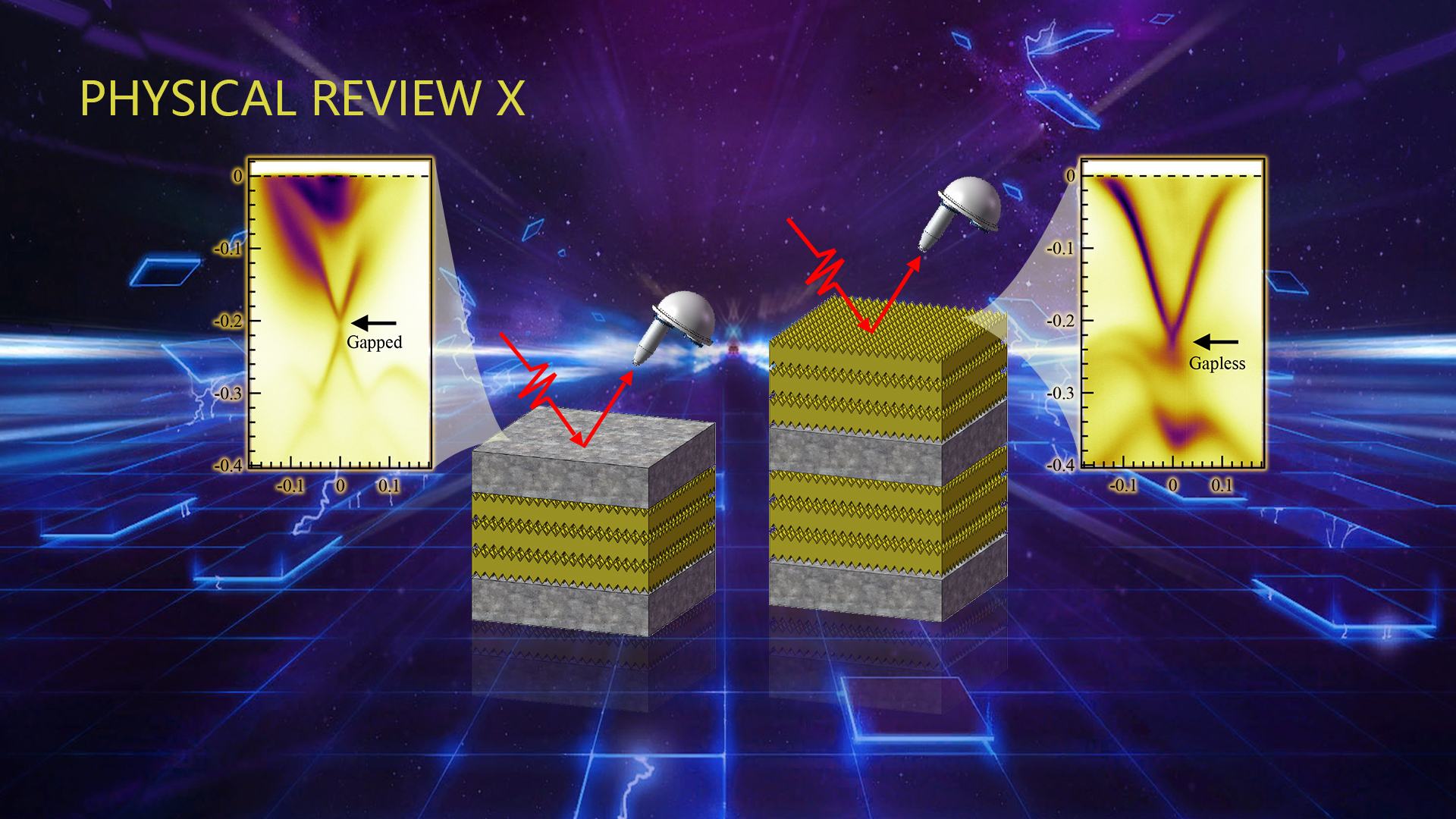Recently, Associate Professors Chaoyu Chen, Qihang Liu, and Chang Liu from the Shenzhen Institute for Quantum Science and Engineering (SIQSE) and the Department of Physics at the Southern University of Science and Technology (SUSTech), collaborated with Beamline Scientist Dr. Eike F. Schwier from the Hiroshima Synchrotron Radiation Center (HiSOR) at Hiroshima University, published an article in the renowned journal, Physical Review X, on February 26, entitled “Half-Magnetic Topological Insulator with Magnetization-Induced Dirac Gap at a Selected Surface.” This work was highly recommended by reviewers and considered the experimental result “an interesting and potentially important observation.”

Topological insulators (TIs) are a kind of novel material hosting a special electronic structure, featuring insulating interiors and conducting surfaces. In the language of “energy band structure”, there exists an X-shaped, conductive, surface band between the “band gap” formed by their insulating bulk. Ordered electronic spins generated by magnetic elements generally destroy the surface conductivity of the TIs by opening a gap also at the surface band. Such magnetic TIs are promised to host two exotic quantum phenomena: the “quantum anomalous Hall effect (QAHE)” and the “axion insulating state.”
Signified by an intrinsic integer-quantized Hall resistivity, The QAHE state promises potential application in low power consumption, high-speed spintronic devices, and future topological quantum computation. In contrast, the axion insulator presents half-quantized surface resistivity (half-integer quantum Hall effect) and topological magnetoelectric effect. Importantly, the realization of both quantum phenomena requires a surface band gap due to magnetism. Scientists have made many efforts in the past decades in search of such magnetism-induced surface gaps. Up to now, the QAHE has been realized in a doped ferromagnetic TI [C.-Z. Chang et al., Science 340, 167 (2013)] and stoichiometric antiferromagnetic TI of MnBi2Te4 [Y. Deng, et al., Science 367, 895 (2020)]. Partially due to the lack of suitable material, it is thus far not clear if the “axion insulating state” can be observed.
The newly discovered van der Waals (vdW) magnetic compounds (MnBi2Te4)(Bi2Te3)n (n = 0, 1, 2, …) are thus far the only stoichiometric magnetic TIs that enables both the QAHE and the axion insulating state. However, recent experimental results unexpectedly revealed nearly gapless surface bands (conducting surface) for the n = 0, 1, and 2 compounds, raising the question of whether a surface band gap exists in the Mn-Bi-Te family. A previous paper on the gapless Dirac cone or conducting surface state of MnBi2Te4 (Y.-J. Hao et al., Gapless Surface Dirac Cone in Antiferromagnetic Topological Insulator MnBi2Te4, Physical Review X 9, 041038 (2019)) was firstly issued by Associate Professors Chang Liu, Qihang Liu, and Chaoyu Chen’s team. Therefore, it is still highly desirable to find a magnetic TI that has a clear gapped surface band, which results unambiguously from magnetism. In other words, the existence of such a surface gap must be related to the bulk magnetic transition, above which the bulk magnetism vanishes, the surface gap closes, and the material becomes a normal TI.
In the reported research, through experiments, the authors find that an intrinsic ferromagnetic TI, MnBi2Te4 (Bi2Te3)3 (MnBi8Te13, n = 3), can be an ideal platform for exploring the key signature of axion dynamics and manipulating exotic half-integer quantum Hall effect. Using angle-resolved photoemission, a technique that observes energy bands directly, they discovered the long-sought magnetic surface gap in MnBi8Te13. The gap decreases monotonically with increasing temperature and closes right at the transition temperature where its ferromagnetism vanishes (Figure 1), the first smoking-gun evidence of magnetization-induced topological surface gap among all known magnetic TIs. This phenomenon happens only at its magnetic, MnBi2Te4 layer but not at its nonmagnetic, Bi2Te3 layers. They further demonstrate theoretically that this system can be termed a “half-magnetic topological insulator”, possessing a half-QAHE, which would be direct proof of the general concept of axion electrodynamics in condensed matter systems.

Figure 1. Temperature dependence of the surface band gap in the magnetic, MnBi2Te4 layer of MnBi8Te13. The spectra were collected by ARPES, a technique that observes energy bands directly. (c), (f), and (g) are the energy distribution curve (EDC) extracted from the temperature-dependent spectra such as (b), (e), and their fitting with multiple Lorentzian peaks.
Dr. Ruie Lu, Dr. Hongyi Sun, and Ph.D. student Yuan Wang from the SIQSE and the Department of Physics at SUSTech, and Dr. Shiv Kumar of the HiSOR at Hiroshima University are the co-first authors. Associate Professor Chaoyu Chen, Qihang Liu, and Chang Liu from the SIQSE and the Department of Physics at SUSTech, and Dr. Eike F. Schwier of the HiSOR at Hiroshima University are the corresponding authors of this paper.
This work was supported by the National Key R&D Program of China, the National Natural Science Foundation of China (NSFC), the Shenzhen High-level Special Fund, the Guangdong Innovative and Entrepreneurial Research Team Program, Shenzhen Science and Technology Program, the University Innovative Team in Guangdong Province, the Technology and Innovation Commission of Shenzhen Municipality, the Highlight Project of the College of Science at SUSTech, Guangdong Provincial Key Laboratory for Computational Science and Material Design, and Center for Computational Science and Engineering of SUSTech. ARPES measurements were performed with the approval of the Proposal Assessing Committee of the HiSOR.
Paper link: https://journals.aps.org/prx/abstract/10.1103/PhysRevX.11.011039
Proofread ByAdrian Cremin, Yingying XIA
Photo By